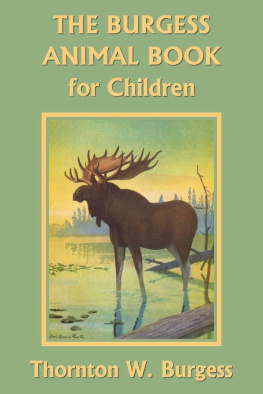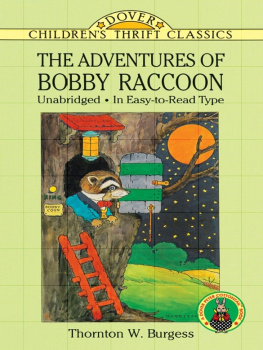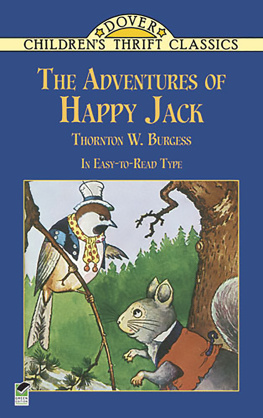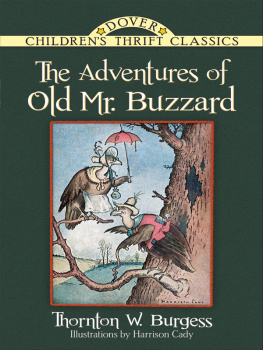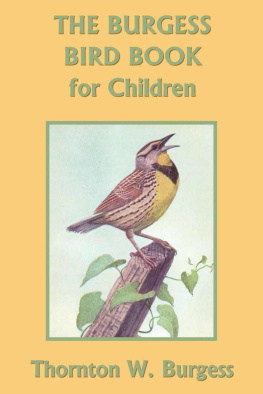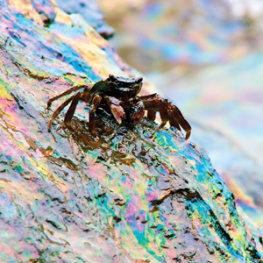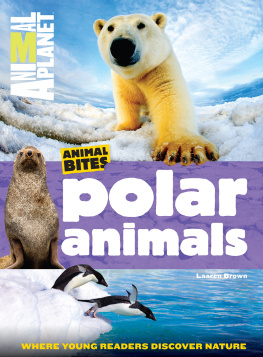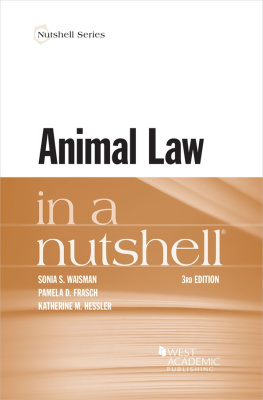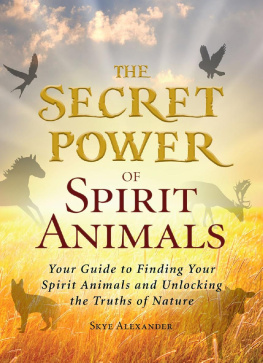The Burgess Animal Book for Children
by
Thornton W. Burgess
Yesterday's Classics
Chapel Hill, North Carolina
Cover and Arrangement 2010 Yesterday's Classics, LLC
All rights reserved. No part of this book may be reproduced or retransmitted in any form or by any means without the written permission of the publisher.
This edition, first published in 2010 by Yesterday's Classics, an imprint of Yesterday's Classics, LLC, is an unabridged republication of the work originally published by Little, Brown & Co. in 1920. This title is available in a print edition (ISBN 978-1-59915-171-7).
Yesterday's Classics, LLC
PO Box 3418
Chapel Hill, NC 27515
Yesterday's Classics
Yesterday's Classics republishes classic books for children from the golden age of children's literature, the era from 1880 to 1920. Many of our titles are offered in high-quality paperback editions, with text cast in modern easy-to-read type for today's readers. The illustrations from the original volumes are included except in those few cases where the quality of the original images is too low to make their reproduction feasible. Unless specified otherwise, color illustrations in the original volumes are rendered in black and white in our print editions.
Preface
The cordial reception given the Burgess Bird Book for Children, together with numerous letters to the author asking for information on the habits and characteristics of many of the mammals of America, led to the preparation of this volume. It is offered merely as an introduction to the four-footed friends, little and big, which form so important a part of the wild life of the United States and Canada.
There has been no attempt to describe or classify sub-species. That is for the scientist and student with specific interests. The purpose of this book is to acquaint the reader with the larger groupsorders, families, and divisions of the latter, so that typical representatives may be recognized and their habits understood.
Instead of the word mammal, the word animal has been used throughout as having a better defined meaning to the average child. A conscientious effort to avoid technical terms and descriptions has been made that there may be nothing to confuse the young mind. Clarity and simplicity have been the objects kept constantly in view.
At the same time the utmost care to be accurate in the smallest details has been exercised. To this end the works of leading authorities on American mammals have been carefully consulted and compared. No statements which are not confirmed by two or more naturalists of recognized standing have been made.
In this research work the writings of Audubon and Bachman, Dr. E.W. Neson, Dr. C. Hart Merriam, Dr. W.T. Hornaday, Ernest Thompson Seton and others, together with the bulletins of the Biological Survey of the Department of Agriculture at Washington, have been of the greatest value. I herewith acknowledge my debt to these.
Whatever the text may lack in clearness of description will be amply compensated for by the wonderful drawings in color and black-and-white by Mr. Louis Agassiz Fuertes, the artist-naturalist, whose hearty cooperation has been a source of great help to me. These drawings were made especially for this book and add in no small degree to such value as it may possess.
If the reading of these pages shall lead even a few to an active interest in our wild animals, stimulating a desire to preserve and protect a priceless heritage from the past which a heedless present threatens through wanton and reckless waste to deny the future, the labor will have been well worth while.
Only through intimate acquaintance may understanding of the animals in their relations to each other and to man be attained. To serve as a medium for this purpose this book has been written. As such I offer it to the children of America, conscious of its shortcomings yet hopeful that it will prove of some value in acquainting them with their friends and minethe animals of field and wood, of mountain and desert, in the truest sense the first citizens of America.
THORNTON W. BURGESS
Contents
CHAPTER I
Jenny Wren Gives Peter Rabbit an Idea
"A S sure as you're alive now, Peter Rabbit, some day I will catch you," snarled Reddy Fox, as he poked his black nose in the hole between the roots of the Big Hickory-tree which grows close to the Smiling Pool. "It is lucky for you that you were not one jump farther away from this hole."
Peter, safe inside that hole, didn't have a word to say, or, if he did, he didn't have breath enough to say it. It was quite true that if he had been one jump farther from that hole, Reddy Fox would have caught him. As it was, the hairs on Peter's funny white tail actually had tickled Reddy's back as Peter plunged frantically through the root-bound entrance to that hole. It had been the narrowest escape Peter had had for a long, long time. You see, Reddy Fox had surprised Peter nibbling sweet clover on the bank of the Smiling Pond, and it had been a lucky thing for Peter that that hole, dug long ago by Johnny Chuck's grandfather, had been right where it was. Also, it was a lucky thing that old Mr. Chuck had been wise enough to make the entrance between the roots of that tree in such a way that it could not be dug any larger.
Reddy Fox was too shrewd to waste any time trying to dig it larger. He knew there wasn't room enough for him to get between those roots. So, after trying to make Peter as uncomfortable as possible by telling him what he, Reddy, would do to him when he did catch him, Reddy trotted off across the Green Meadows. Peter remained where he was for a long time. When he was quite sure that it was safe to do so, he crept out and hurried, lipperty-lipperty-lip, up to the Old Orchard. He felt that that would be the safest place for him, because there were ever so many hiding places in the old stone wall along the edge of it.
When Peter reached the Old Orchard, who should he see but Jenny Wren. Jenny had arrived that very morning from the Sunny South where she had spent the winter. "Tut, tut, tut, tut, tut!" exclaimed Jenny as soon as she saw Peter. "If here isn't Peter Rabbit himself! How did you manage to keep out of the clutches of Reddy Fox all the long winter?"
Peter chuckled. "I didn't have much trouble with Reddy during the winter," said he, "but this very morning he so nearly caught me that it is a wonder that my hair is not snow white from fright." Then he told Jenny all about his narrow escape. "Had it not been for that handy hole of Grandfather Chuck, I couldn't possibly have escaped," concluded Peter.
Jenny Wren cocked her pert little head on one side, and her sharp little eyes snapped. "Why don't you learn to swim, Peter, like your cousin down in the Sunny South?" she demanded. "If he had been in your place, he would simply have plunged into the Smiling Pool and laughed at Reddy Fox."
Peter sat bolt upright with his eyes very wide open. In them was a funny look of surprise as he stared up at Jenny Wren. "What are you talking about, Jenny Wren?" he demanded. "Don't you know that none of the Rabbit family swim unless it is to cross the Laughing Brook when there is no other way of getting to the other side, or when actually driven into the water by an enemy from whom there is no other escape? I can swim a little if I have to, but you don't catch me in the water when I can stay on land. What is more, you won't find any other members of my family doing such a thing."
"Tut, tut, tut, tut, Peter!" exclaimed Jenny Wren in her sharp, scolding voice. "Tut, tut, tut, tut! For a fellow who has been so curious about the ways of his feathered neighbors, you know very little about your own family. If I were in your place I would learn about my own relatives before I became curious about my neighbors. How many relatives have you, Peter?"

